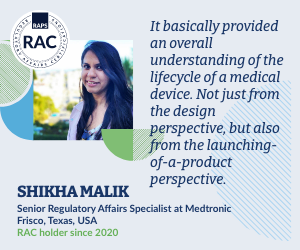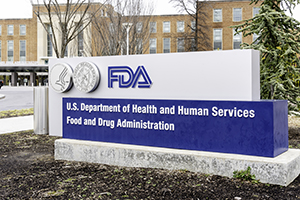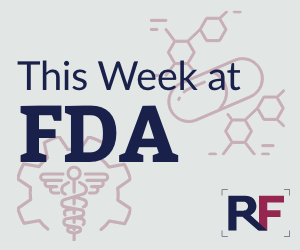This Week at FDA: User fee update, Califf nomination, and more
![]() This Week at FDA | 14 January 2022 |
This Week at FDA | 14 January 2022 |
Correction: This article was edited on 18 January 2022 to clarify the number of enforcement letters sent by the Office of Prescription Drug Promotion in 2021
Welcome to another edition of This Week at FDA! There were some major developments this week with potential ramifications for FDA in the coming years, as well as many other updates and actions from the agency. We hear that HHS has transmitted three of FDA’s user fee packages to Congress – with one notable exception – and, as we reported on Thursday, FDA is one step closer to having a permanent commissioner.
Earlier this week, we read that FDA and the medical device industry were still about $1 billion apart in their negotiations over MDUFA V, just days before the deadline set by Congress to submit the agreement. Now, Politico reports that the Department of Health and Human Services (HHS) has transmitted the packages for PDUFA VII, GDUFA III and BsUFA III to Congress on time, with MDUFA V still awaiting finalization.
On Thursday, the Senate HELP committee voted 13-8, with one member not voting, to advance Robert Califf’s nomination to the full Senate for a vote. While Califf picked up some Republican support, he will need even more Republican votes to overcome the handful of Democratic senators who have said they oppose his nomination. A conformation vote has not yet been scheduled.
FDA also published a report providing an overview of its activities and accomplishments in 2021.
Drugs and biologics
This week, FDA also posted an untitled letter sent by the Office of Prescription Drug Promotion (OPDP) to Eli Lilly concerning television ads for its migraine drug Emgality (galcanezumab-gnlm) in December of last year.
The letter was the sixth enforcement letter sent by OPDP in 2021*, which sent a total of four untitled letters and two warning letters to drugmakers that year. The letter was already closed out by the time the agency published the letter, and it appears that it was brought on by some confusion stemming from how parts of a multi-part TV ad were submitted to the agency. In its response to the untitled letter, Eli Lilly explained that the ads “were intended to be aired on broadcast television together in immediate, sequential fashion,” and that, “All three components should be viewed in totality.” FDA’s response points out that the company did not submit the “complete TV broadcast,” which Eli Lilly admitted “may have contributed to confusion.”
FDA also issued a safety communication warning about the risks of dental problems associated with the use of buprenorphine products that are dissolved in the mouth to treat opioid use disorder and pain. The agency said that, “Dental problems (including tooth decay, cavities, dental abscesses/infection, tooth erosion, and, in some cases, total tooth loss), have been reported even in patients with no history of dental issues.” However, the agency said it “cannot determine” how likely such issues are to occur in patients taking buprenorphine products that dissolve in the mouth but that, “The benefits … clearly outweigh the risks” and that such products are “important tools” for treating opioid use disorder and pain.
In biologics news, FDA revoked its regulations for human tissue intended for transplantation and human dura mater recovered prior to 25 May 2005. “The Agency does not believe there are currently any tissues intended for transplantation remaining in inventory that were recovered prior to this date and that would be subject to these regulations,” FDA wrote in the Federal Register. Human cells, tissues and cellular and tissue-based products (HCT/Ps) recovered after that date are covered under separate regulations.
The Center for Biologics Evaluation and Research (CBER) also posted that it is recruiting for multiple staff fellow positions as pharmacology/toxicology reviewers to serve at the Office of Tissues and Advanced Therapies (OTAT) Division of Clinical Evaluation and Pharmacology/Toxicology (DCEPT). Applications for the position are open until 17 March 2022.
Devices
This week, FDA finalized a rule to end its practice of publishing quarterly lists of its approval or denial decisions for premarket approval applications (PMAs) and humanitarian device exemptions (HDEs) in the Federal Register. The agency first proposed ending the practice in December 2019, writing that the move would improve efficiency and eliminate duplication in publishing the decisions, which are published along with additional information on its website.
The Center for Devices and Radiological Health (CDRH) issued a safety communication providing an update on the risk of Type III endoleaks with the use of Endologix AFX endovascular grafts following a meeting of the Circulatory System Devices Panel of the Medical Devices Advisory Committee in November. While the committee largely supported the continued availability of the device for certain populations, it recommended that AFX2 endovascular grafts not be used for routine abdominal aortic aneurism (AAA) treatment.
FDA also announced a Class I recall for Cardiovascular Systems, Inc’s Wirion Embolic Protection Device following complaints of filter breakage during retrieval and issued an order classifying electrocardiograph software for over-the-counter use into class II (special controls).
In other device news, CDRH also released its quarterly third-party review organization performance report, covering Q1 of FY2022.
Welcome to another edition of This Week at FDA! There were some major developments this week with potential ramifications for FDA in the coming years, as well as many other updates and actions from the agency. We hear that HHS has transmitted three of FDA’s user fee packages to Congress – with one notable exception – and, as we reported on Thursday, FDA is one step closer to having a permanent commissioner.
Earlier this week, we read that FDA and the medical device industry were still about $1 billion apart in their negotiations over MDUFA V, just days before the deadline set by Congress to submit the agreement. Now, Politico reports that the Department of Health and Human Services (HHS) has transmitted the packages for PDUFA VII, GDUFA III and BsUFA III to Congress on time, with MDUFA V still awaiting finalization.
On Thursday, the Senate HELP committee voted 13-8, with one member not voting, to advance Robert Califf’s nomination to the full Senate for a vote. While Califf picked up some Republican support, he will need even more Republican votes to overcome the handful of Democratic senators who have said they oppose his nomination. A conformation vote has not yet been scheduled.
FDA also published a report providing an overview of its activities and accomplishments in 2021.
Drugs and biologics
This week, FDA also posted an untitled letter sent by the Office of Prescription Drug Promotion (OPDP) to Eli Lilly concerning television ads for its migraine drug Emgality (galcanezumab-gnlm) in December of last year.
The letter was the sixth enforcement letter sent by OPDP in 2021*, which sent a total of four untitled letters and two warning letters to drugmakers that year. The letter was already closed out by the time the agency published the letter, and it appears that it was brought on by some confusion stemming from how parts of a multi-part TV ad were submitted to the agency. In its response to the untitled letter, Eli Lilly explained that the ads “were intended to be aired on broadcast television together in immediate, sequential fashion,” and that, “All three components should be viewed in totality.” FDA’s response points out that the company did not submit the “complete TV broadcast,” which Eli Lilly admitted “may have contributed to confusion.”
FDA also issued a safety communication warning about the risks of dental problems associated with the use of buprenorphine products that are dissolved in the mouth to treat opioid use disorder and pain. The agency said that, “Dental problems (including tooth decay, cavities, dental abscesses/infection, tooth erosion, and, in some cases, total tooth loss), have been reported even in patients with no history of dental issues.” However, the agency said it “cannot determine” how likely such issues are to occur in patients taking buprenorphine products that dissolve in the mouth but that, “The benefits … clearly outweigh the risks” and that such products are “important tools” for treating opioid use disorder and pain.
In biologics news, FDA revoked its regulations for human tissue intended for transplantation and human dura mater recovered prior to 25 May 2005. “The Agency does not believe there are currently any tissues intended for transplantation remaining in inventory that were recovered prior to this date and that would be subject to these regulations,” FDA wrote in the Federal Register. Human cells, tissues and cellular and tissue-based products (HCT/Ps) recovered after that date are covered under separate regulations.
The Center for Biologics Evaluation and Research (CBER) also posted that it is recruiting for multiple staff fellow positions as pharmacology/toxicology reviewers to serve at the Office of Tissues and Advanced Therapies (OTAT) Division of Clinical Evaluation and Pharmacology/Toxicology (DCEPT). Applications for the position are open until 17 March 2022.
Devices
This week, FDA finalized a rule to end its practice of publishing quarterly lists of its approval or denial decisions for premarket approval applications (PMAs) and humanitarian device exemptions (HDEs) in the Federal Register. The agency first proposed ending the practice in December 2019, writing that the move would improve efficiency and eliminate duplication in publishing the decisions, which are published along with additional information on its website.
The Center for Devices and Radiological Health (CDRH) issued a safety communication providing an update on the risk of Type III endoleaks with the use of Endologix AFX endovascular grafts following a meeting of the Circulatory System Devices Panel of the Medical Devices Advisory Committee in November. While the committee largely supported the continued availability of the device for certain populations, it recommended that AFX2 endovascular grafts not be used for routine abdominal aortic aneurism (AAA) treatment.
FDA also announced a Class I recall for Cardiovascular Systems, Inc’s Wirion Embolic Protection Device following complaints of filter breakage during retrieval and issued an order classifying electrocardiograph software for over-the-counter use into class II (special controls).
In other device news, CDRH also released its quarterly third-party review organization performance report, covering Q1 of FY2022.
© 2025 Regulatory Affairs Professionals Society.














